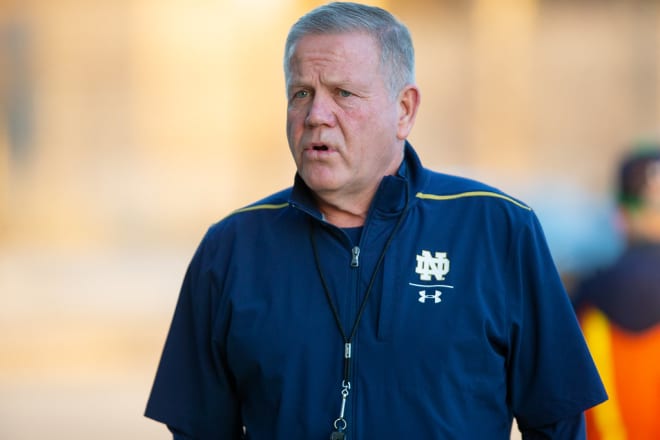Brian Kelly, Notre Dame Football Feel Well-Prepared For The NIL Era
A rule change and new era of college athletics Notre Dame has supported is now reality.
Effective Thursday, college athletes are allowed to earn money for use of their name, image and likeness (NIL). The NCAA’s long-standing bylaws preventing it are no more after its Board of Directors approved national NIL guidelines during a Wednesday meeting.
It’s a voyage into uncharted waters using a ship being built as it’s sailing. The NIL era will likely feature lots of learning on the fly and unforeseen ripple effects. But it’s a journey college athletics has gradually come to accept as necessary.

The route here was uneven, with the NCAA forced to act only because states began passing their own NIL laws in 2019. The NCAA hoped Congress would pass a federal law by Thursday, but when that became unlikely, it took some 11th-hour action to ensure athletes in every state will be allowed to profit from use of their NIL.
Athletes in states with NIL laws will follow those rules. In states without NIL laws, it’s up to individual schools or conferences to adopt their own policies. Indiana is not among the 14 states with NIL laws that take effect Thursday, meaning Notre Dame must write its own NIL rules until the NCAA or Congress passes national policy that supplants the interim guidelines.
Per the NCAA, schools are discouraged from directly setting up deals for their student-athletes. School logos cannot be used in any NIL ventures. But beyond explicit pay-for-play deals (like $500 per touchdown), little is off limits.
Notre Dame will release “something that will be more public” on NIL in early July, head coach Brian Kelly told BlueandGold.com Monday. That announcement is expected to include partnerships with third-party vendors that help connect athletes to NIL opportunities. The athletic department has, though, been readying for this day since last fall, when it formed a committee to study and prepare for the possibilities.
“There are so many things I can rattle off this committee has had to deal with, from how do we handle it from a compliance standpoint to where are we going to give them the guidance in terms of personnel,” Kelly said. “There are a lot of pieces to this, but they began the work back in the fall. I think we’re well-positioned to put something together.”
Given its prior support of NIL rights, Notre Dame’s plan figures to be light on restrictions. On the whole, the football program views it an opportunity to enhance its appeal and its power.
That dovetails into an offseason full of innovation in its recruiting approach. First-year defensive coordinator Marcus Freeman has so far delivered on his renowned recruiting reputation — one of the pluses to hiring him. He talks about closing gaps and acknowledges it takes another level of recruiting to win in the playoff.
Elsewhere, Notre Dame launched a national billboard campaign this spring and created ample social media buzz with its Pot of Gold recruiting day that, rather appropriately, took place March 17.
Those moves were geared toward helping Notre Dame further establish its brand nationally. To Kelly, that same reach potential makes his program and his players attractive partners for NIL deals.
“When you have an iconic brand and a player can co-brand with the sixth-most iconic brand in the sport, how can that not be beneficial?” Kelly said. “How you go about doing it and the mechanics of that is how we’ll have to guide them with what you can and can’t do. But that can only be seen as a positive from that perspective.”
Notre Dame’s June official visit weekends included discussions with recruits about its NIL approach. Notre Dame has also met individually with recruits via Zoom to give them a more personalized version with feedback on their social media pages. Both highlighted how prospects can grow their social media followings and therein make them attractive to potential NIL deals.
Last summer, athlete marketing firm Opendorse estimated former Notre Dame quarterback Ian Book’s potential annual earnings from social media advertisements at more than $178,000. That figure would be a rarity — it was the sixth-highest estimate for any 2020 college football player — but it illustrates the earning power of social media ads.
“They were actually able to give pointers to the kids, ‘This is what you’re doing well, this is what you’re not doing well,’” said the parent of one four-star recruit who took an official visit to Notre Dame this summer. “Which is different than a lot of other places that have been more about, ‘This is how we can brand you’ as opposed to, ‘What are you doing now?’ And there was always a caveat of, ‘If this is what you want.’”
Notre Dame will lean into its brand power in this new landscape, but NIL won’t be a program-wide obsession that overtakes its long-standing selling points and goals. Kelly doesn’t want it to be. Players don’t either, he said — and he knows that from first-hand market research.
“We polled our team in terms of what they were interested in, and there are concerns,” Kelly said. “They don’t want the locker room to be such an imbalance that some are making more than others. They’re afraid of that. They’re not interested in spending a ton of time on name, image and likeness.
“They want to train, play football and enjoy their college years. It’s not something they’ll spend a ton of time on, but they wouldn’t mind a little bit more money.”
All told, Notre Dame isn’t changing the core tenants of its recruiting pitch to revolve around NIL. The usual selling points — academic opportunities, 40-year decisions, life after football, the chance to play on a national stage and compete for championships — will remain at the center of it. If that leads to missing on some recruits who place a larger emphasis on a school’s NIL potential, Kelly is fine with that.
“If you’re in it for Nike gear, in it for the short, then you get what you sign up for because you’re going to lose the other things that come with a place like Notre Dame,” Kelly said. “If you’re in it for the long, we have a name, image and likeness program.
“There will be those who take it on the short, but we weren’t going to get those guys anyway. We’re going to focus on the guys who recognize what the brand power is at Notre Dame, and they’ll understand the long of this instead of the short.”
On the same tune, the parent added: “I don’t think it’s going to play a part in [my son’s] decision-making process. I think it’s just a bonus.”
But one Notre Dame knows it has to embrace, or risk getting left behind.
“We’re going to take the lead on what we’re hearing from our guys as well,” Kelly said, “to see how we can meet those needs.”

----
• Learn more about our print and digital publication, Blue & Gold Illustrated.
• Watch our videos and subscribe to our YouTube channel.
• Sign up for Blue & Gold's news alerts and daily newsletter.
• Subscribe to our podcast on Apple Podcasts.
• Follow us on Twitter: @BGINews, @Rivals_Singer, @PatrickEngel_, @tbhorka and @ToddBurlage.
• Like us on Facebook.


